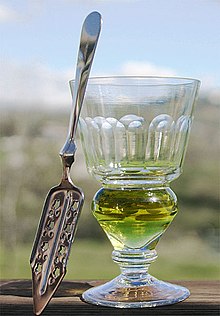 Reservoir glass with naturally coloured verte absinthe and an absinthe spoon | |
| Type | Spirit |
|---|---|
| Country of origin | Switzerland, France |
| Alcohol by volume | 45–74% |
| Proof (US) | 90–148 |
| Colour | Green |
| Flavour | Anise |
| Ingredients | |
Absinthe (/ˈæbsɪnθ, -sæ̃θ/, French: [apsɛ̃t] ) is an anise-flavored spirit derived from several plants, including the flowers and leaves of Artemisia absinthium ("grand wormwood"), together with green anise, sweet fennel, and other medicinal and culinary herbs.[1] Historically described as a highly alcoholic spirit, it is 45–74% ABV or 90–148 proof in the US.[2][3][4][5] Absinthe traditionally has a natural green color but may also be colorless. It is commonly referred to in historical literature as la fée verte 'the green fairy'. While sometimes casually referred to as a liqueur, absinthe is not traditionally bottled with sugar or sweeteners.[6] Absinthe is traditionally bottled at a high level of alcohol by volume, but it is normally diluted with water before being consumed.
Absinthe was created in the canton of Neuchâtel in Switzerland in the late 18th century by the French physician Pierre Ordinaire.[7][8] It rose to great popularity as an alcoholic drink in late 19th- and early 20th-century France, particularly among Parisian artists and writers. The consumption of absinthe was opposed by social conservatives and prohibitionists, partly due to its association with bohemian culture. From Europe and the Americas, notable absinthe drinkers included Ernest Hemingway, James Joyce, Lewis Carroll, Charles Baudelaire, Paul Verlaine, Arthur Rimbaud, and Henri de Toulouse-Lautrec.[9][10]
Absinthe has often been portrayed as a dangerously addictive psychoactive drug and hallucinogen, which gave birth to the term absinthism.[11] The chemical compound thujone, which is present in the spirit in trace amounts, was blamed for its alleged harmful effects. By 1915, absinthe had been banned in the United States and in much of Europe, including France, the Netherlands, Belgium, Switzerland, and Austria-Hungary, yet it has not been demonstrated to be any more dangerous than ordinary spirits. Recent studies have shown that absinthe's psychoactive properties (apart from those attributable to alcohol) have been exaggerated.[11]
A revival of absinthe began in the 1990s, following the adoption of modern European Union food and beverage laws that removed long-standing barriers to its production and sale. By the early 21st century, nearly 200 brands of absinthe were being produced in a dozen countries, most notably in France, Switzerland, Austria, Germany, the Netherlands, Spain, and the Czech Republic.
- ^ Chisholm, Hugh, ed. (1911). . Encyclopædia Britannica. Vol. 1 (11th ed.). Cambridge University Press. p. 75.
- ^ Duplais, P. (1882). Traite de la Fabrication de Liqueurs et de la Distillation des Alcools (in French) (3rd ed.). pp. 375–378.
- ^ Fritsch, J. (1926). Nouveau Traité de la Fabrication des Liqueurs (in French). pp. 385–401.
- ^ De Brevans, J. (1908). La Fabrication des Liqueurs (in French). pp. 251–262.
- ^ Lebead; de Fontenelle; Malepeyre (1888). Nouveau Manuel Complet du Distillateur Liquoriste (in French). pp. 221–224.
- ^ Duplais (1882). Traite de la Fabrication de Liqueurs et de la Distillation des Alcools (in French) (3rd ed.). p. 249.
- ^ Wittels, Betina J.; Hermesch, Robert (2003). Absinthe: Sip of Seduction. Speck Press. ISBN 978-0-9725776-1-8.
- ^ Wittels, Betina; Breaux, T. A. (6 June 2017). Absinthe: The Exquisite Elixir. Fulcrum Publishing. ISBN 978-1-68275-156-5.
- ^ "The Appeal of 'The Green Fairy'". Sarasota Herald-Tribune. 18 September 2008. Archived from the original on 20 January 2016. Retrieved 3 February 2022.
- ^ Arnold, Wilfred Niels (1988). "Vincent van Gogh and the Thujone Connection'". JAMA: The Journal of the American Medical Association. 260 (20): 3042–3044. doi:10.1001/jama.1988.03410200098033. PMID 3054185.
- ^ a b Padosch, Stephan A; Lachenmeier, Dirk W.; Kröner, Lars U. (2006). "Absinthism: a fictitious 19th century syndrome with present impact". Substance Abuse Treatment, Prevention, and Policy. 1: 14. doi:10.1186/1747-597X-1-14. PMC 1475830. PMID 16722551.